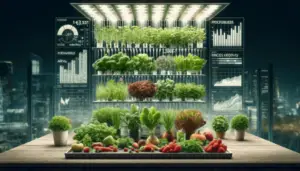Aeroponics, a method of growing plants without soil by suspending the roots in the air and misting them with a nutrient-rich solution, offers numerous benefits including faster growth rates, higher yields, and efficient resource use. But when it comes to profitability, certain plants stand out more than others. This article explores the most profitable plants to grow in an aeroponic system, considering market demand, growth rate, and return on investment.

Why Aeroponics?
Before diving into specific plants, it’s important to understand why aeroponics is a highly efficient method for growing profitable crops:
-
Faster Growth Rates: Aeroponics allows for optimal oxygenation and nutrient delivery, resulting in faster plant growth compared to soil-based methods.
-
Higher Yields: The precision of nutrient delivery and environmental control in aeroponics leads to higher yields per plant.
-
Water Efficiency: Aeroponics uses up to 98% less water than traditional farming methods, making it ideal for regions with limited water resources.
-
Space Efficiency: Vertical aeroponic systems maximize space usage, making them perfect for urban farming and small-scale operations.
The Most Profitable Plants to Grow in Aeroponics
1. Leafy Greens
Leafy greens such as lettuce, spinach, and kale are among the most profitable plants to grow in an aeroponic system. They have a fast growth cycle, high market demand, and fetch good prices in the market.
Lettuce
Lettuce is particularly well-suited for aeroponics due to its rapid growth rate and high yield potential. Varieties like Romaine, Butterhead, and Leaf Lettuce are popular choices.
-
Growth Cycle: 30-45 days
-
Market Price: $2-$4 per head
-
Advantages: High demand, quick turnover, and can be grown year-round.
Spinach
Spinach is another profitable leafy green that thrives in aeroponic systems. It has a slightly longer growth cycle than lettuce but offers high nutritional value, making it a favorite among health-conscious consumers.
-
Growth Cycle: 40-50 days
-
Market Price: $3-$5 per bunch
-
Advantages: High nutritional value, consistent market demand, and suitable for continuous harvesting.
Kale
Kale is known for its health benefits and versatility in culinary applications. Its robust growth and high yield make it a profitable crop for aeroponic farming.
-
Growth Cycle: 50-60 days
-
Market Price: $3-$5 per bunch
-
Advantages: High market value, strong demand for health foods, and year-round production capability.
2. Herbs
Herbs such as basil, mint, and cilantro are highly profitable due to their high market value and relatively low space requirements. They grow quickly and can be harvested multiple times, increasing their profitability.
Basil
Basil is one of the most popular herbs grown in aeroponic systems. It has a high market value and is in constant demand in both fresh and dried forms.
-
Growth Cycle: 20-30 days
-
Market Price: $3-$6 per bunch
-
Advantages: High demand, multiple harvests per cycle, and versatility in culinary uses.
Mint
Mint grows rapidly in aeroponic systems and can be harvested frequently. Its aromatic leaves are used in a variety of culinary and medicinal applications.
-
Growth Cycle: 20-30 days
-
Market Price: $2-$5 per bunch
-
Advantages: Fast growth, consistent demand, and multiple harvests.
Cilantro
Cilantro, also known as coriander, is another profitable herb for aeroponic farming. It has a quick growth cycle and is used in many cuisines worldwide.
-
Growth Cycle: 30-40 days
-
Market Price: $2-$4 per bunch
-
Advantages: High demand in culinary applications, quick turnover, and multiple harvests.
3. Microgreens
Microgreens are young vegetable greens harvested just after the first true leaves develop. They are highly nutritious and fetch premium prices in the market.
Arugula Microgreens
Arugula microgreens are known for their peppery flavor and nutritional benefits. They grow quickly and are highly valued by chefs and health enthusiasts.
-
Growth Cycle: 10-14 days
-
Market Price: $25-$50 per pound
-
Advantages: High market value, rapid growth, and high nutritional content.
Radish Microgreens
Radish microgreens have a spicy flavor and vibrant color, making them popular for garnishes and salads. They are easy to grow and have a short growth cycle.
-
Growth Cycle: 7-10 days
-
Market Price: $20-$40 per pound
-
Advantages: Quick turnaround, high market demand, and easy cultivation.
Broccoli Microgreens
Broccoli microgreens are packed with nutrients and antioxidants. They have a mild flavor and are used in various culinary applications.
-
Growth Cycle: 10-14 days
-
Market Price: $25-$50 per pound
-
Advantages: High nutritional value, short growth cycle, and strong market demand.
4. Strawberries
Strawberries are a high-value crop that can be grown effectively in aeroponic systems. They require careful management but offer substantial returns due to their high market prices.
-
Growth Cycle: 60-90 days
-
Market Price: $3-$6 per pound
-
Advantages: High market value, strong consumer demand, and potential for year-round production.
5. Tomatoes
Tomatoes, especially cherry and grape varieties, can be highly profitable when grown in aeroponic systems. They require more attention and longer growth periods but yield high returns.
-
Growth Cycle: 70-90 days
-
Market Price: $3-$5 per pound
-
Advantages: High demand, versatile culinary uses, and high yield potential.
Factors Influencing Profitability
Market Demand
Understanding local and regional market demand is crucial for choosing the most profitable crops. Research the demand for various crops in your area to ensure a steady market for your produce.
Growth Cycle and Turnover
Crops with shorter growth cycles and multiple harvests per year can generate higher profits due to quicker turnover and increased productivity.
Space and Resource Efficiency
Maximizing space and resource efficiency in your aeroponic system can enhance profitability. Vertical farming techniques and efficient nutrient management can help achieve this.
Quality and Consistency
Maintaining high-quality produce and consistent supply is essential for securing premium prices and repeat customers. Invest in reliable aeroponic systems and maintain optimal growing conditions to ensure the best results.
Conclusion: The Most Profitable Aeroponic Crops
Growing profitable crops in an aeroponic system requires careful selection based on market demand, growth rate, and return on investment. Leafy greens, herbs, microgreens, strawberries, and tomatoes are among the most profitable plants to grow in aeroponics. By focusing on these high-value crops and optimizing your growing conditions, you can achieve a successful and profitable aeroponic farming operation.
Recommended Products for Aeroponic Systems
To help you get started with profitable aeroponic farming, consider these trusted products:
Lettuce Grow Farmstand
The Lettuce Grow Farmstand offers an easy-to-use aeroponic system that is perfect for both beginners and experienced growers.
Growace Nutrient Solutions
Growace provides high-quality nutrient solutions and equipment designed to optimize the performance of aeroponic systems.
NuAqua Reverse Osmosis Systems
Ensure your aeroponic system uses the purest water with NuAqua’s reverse osmosis systems, preventing issues that can affect plant health.
By selecting the right crops and using high-quality products, you can maximize the profitability of your aeroponic farming venture. Happy growing!
